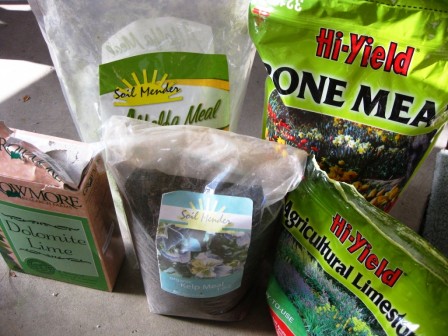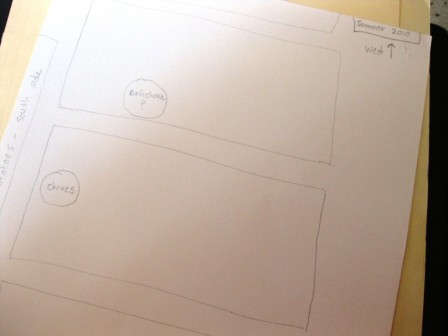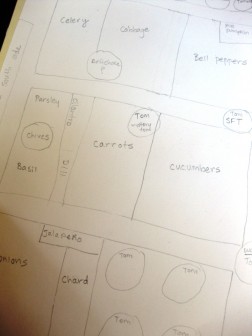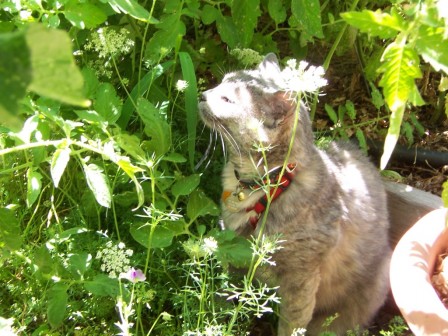Wanna know the best piece of garden advice I’ve ever gotten? “Feed the soil, not the plants.” Yeah! It took me a while to actually appreciate the truth in that statement, but through first-hand experience, I now know that if you concentrate on building rich & delicious soil, you will most certainly get rewarded with much better vegetable harvests — and I do mean MUCH better!!
I amend my soil once a year, in the spring, and like to use 3 different amendments:
– Leaves that have been mulching the garden since autumn
– 1/2″ layer (or more) of composted cow (or other) manure or finished compost
– Dry, organic fertilizer mix (recipes below)
Let me explain…
– Leaves:
As I mentioned last fall, I don’t like to dig or amend my soil in the fall…but rather wait until the spring time. So over the past few weeks, I’ve been gradually pulling away the thick layer of leaves that I had put on the garden in October. The reason I say “gradually” is because once you pull away the dry top layer, there’s a moist layer underneath. You could of course just dig these moist leaves in right away, but my soil was still quite wet, and I wanted it to dry out a bit before digging (digging wet soil is not good for the garden since it destroys the structure of the soil, causing it to compact and dry into brick-like clods). Also, you’ll notice that when you expose the wet leaves, there will probably be lots of worms in that layer. I like to give the worms a chance to burrow back into the soil before I pull off that layer of wet leaves…otherwise you’d be pulling off precious worms that you want to keep in your garden.
Anyway, I dig a thin layer of leaves into the soil, and will use the rest to mulch around my plants as they get bigger.
– Manure or Compost:
If you use manure, it should be composted, not fresh (so as not to burn your plants with nitrogen, and also to prevent the spread of pathogens). I buy mine from the garden center. Important side note: there’s a growing problem with herbicide-contaminated compost (both animal- and plant-based) being sold; this is bad news for gardeners since it has a very negative impact on the growth of crops, and it persists in the soil for years. Read the full story here, and an update here. So in light of all that, if you make your own compost, definitely use it!
– Organic Fertilizer Mix:
First, the recipes!
Here are a couple of dry, organic fertilizer recipes from my favorite vegetable gardening book, Rodale’s Garden Answers – Vegetables, Fruits, and Herbs:
For every 100 square feet of garden space, mix together:
6 lbs alfalfa meal
3 lbs bone meal
4 lbs greensand
1 lb kelp meal
OR, Mix and Match (choose ONE from each category):
Nitrogen (N):
2 parts blood meal – OR – 3 parts fish meal
Phosphorus (P):
3 parts bone meal – OR – 6 parts rock phosphate or colloidal phosphate
Potassium (K):
1 part kelp meal – OR – 6 parts greensand
Unfortunately, the book doesn’t specify how many quarts or pounds to apply for the Mix-n-Match recipe, but I’d guess it would be about 4-6 quarts per 100 sq ft. Or, based on the first recipe, you could figure that 1 part probably equals 1 pound, and measure it out that way.
I used the first Rodale recipe last year with good success; this year, I’m trying the recipe outlined in this Mother Earth News article called “A Better Way to Fertilize Your Garden.” This is probably the best, most helpful organic fertilizer article I’ve seen. It’s worth reading!
As for sourcing ingredients, I was sorely disappointed in the organic fertilizer selection at my local garden centers (do that many people still use all those chemicals?! :-(). I went to four different places before I got what I wanted, and no doubt paid a premium. Next time I’ll go ahead and buy online. Even though the shipping rate might be high because of the weight of the ingredients, it will probably be worth it. Peaceful Valley Farm Supply is a good source, but I’d also do a google search for organic garden suppliers to see who else is out there.
Anyway, in that article, it’s suggested that you initially use 4-6 quarts of fertilizer per 100 square feet (depending on what you’re growing…and possibly adding more throughout the season; more details in the article). I mixed up 7 quarts of fertilizer. The recipe is measured in ratios (“parts”) instead of in cups or pounds, which is annoying if you’re trying to end up with a certain number of quarts. So I did some math to come up with the number of CUPS needed of each ingredient, so that the end result was 7 quarts of fertilizer mix. Measure your ingredients on the generous side, and mix thoroughly before applying to the garden.
7 quarts (28 cups) of fertilizer:
16 cups (4 quarts) alfalfa meal (which is roughly 2.5 – 3 lbs)
2 cups (1 pint) agricultural lime
2 cups (1 pint) dolomite lime
4 cups (1 quart) bone meal
4 cups (1 quart) kelp meal
I dig all 3 amendments into my garden soil in the spring, to a depth of about 4 inches. Once the veggies really get going, I like to supplement my blooming/fruiting veggies with some liquid Neptune’s Harvest Fish/Seaweed emulsion (NPK: 2-3-1), and my leafy greens with Alaska brand Fish Emulsion — though you could certainly use the Fish/Seaweed on all of it. I just happen to have a gallon of the Alaska fish emulsion, so I feed it to the greens since it’s NPK nutrient profile is 5-1-1 (lots of nitrogen!). Instead of the fish emulsion, you could also just dig more dry fertilizer into the soil at regular intervals, as detailed in the fertilizer article, which was linked above.
I hope this was at least kind of helpful…fertilizing the veggie garden had always been a big mystery for me, and within the past couple years, I feel like I’m finally finding my rhythm with it.
Do you have any special organic fertilizer tricks or advice to share??









































